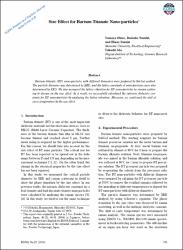Size Effects Observed via the Electrical Response of BaTiO3 Nanoparticles in a Cavity

View/
Access
info:eu-repo/semantics/closedAccessDate
2012Author
Lomax, Joseph F.Fontanella, John J.
Edmondson, Charles A.
Wintersgill, Mary C.
Westgate, Mark A.
Eker, Sitki
Metadata
Show full item recordAbstract
Barium titanate (BaTiO3) is one of the most widely used electronic materials. The origin of changing structural and electronic behavior between larger and smaller nano particles in BaTiO3 has been extensively investigated. Here, the dielectric loss measured for BaTiO3 or BaZrO3 particles in a cavity at audio frequencies (10-10(5) Hz) and low temperatures (5.5-350 K) is reported. Distinct differences were found between small (50-100 nm diameter/cubic) and large (>200 nm diameter/tetragonal at room temperature) BaTiO3 particles. Isochronal relaxation features observed around 20 K showed differing shape and dynamics (50-100 nm particles: broad peak, E-act approximate to 0.04 eV, log(10)(f(pre)(s)) approximate to 14.7; >200 nm particles: sharp peak, E-act approximate to 0.025 eV and log(10)(f(pre)(s)) approximate to 12, with a shoulder). The low-temperature relaxations are attributed to the motion of off-center titanium ions. In support of this identification, low-temperature relaxations were not observed in BaZrO3 nanoparticles. Finally, structural change features were observed at about 180 and 270 K in the larger BaTiO3 particles (rhombohedral at low temperature) but not in the smaller particles (cubic at all temperatures). The results provide a new set of testable bounds that should contribute to the understanding of nanoparticle-sized BaTiO3, in particular, and ferroelectric behavior in perovskites, in general.
Source
JOURNAL OF PHYSICAL CHEMISTRY CVolume
116Issue
44Collections
- Scopus İndeksli Yayınlar Koleksiyonu [2612]
- WoS İndeksli Yayınlar Koleksiyonu [3255]
- Yayın Koleksiyonu [223]

















